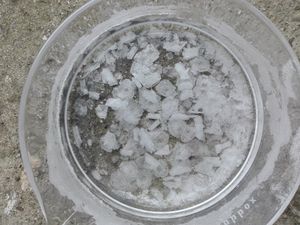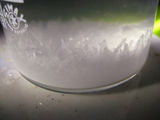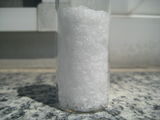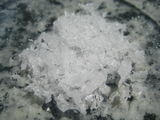Ammonium perchlorate
 Recrystallized ammonium perchlorate
| |
| Names | |
|---|---|
| IUPAC name
Ammonium perchlorate
| |
| Preferred IUPAC name
Ammonium perchlorate | |
| Systematic IUPAC name
Ammonium perchlorate | |
| Other names
AP
Azanium perchlorate Perchloric acid, ammonium salt | |
| Properties | |
| NH4ClO4 | |
| Molar mass | 117.49 g/mol |
| Appearance | White crystalline solid |
| Odor | Odorless |
| Density | 1.95 g/cm3 |
| Melting point | 130 °C (266 °F; 403 K) (decomposes) |
| Boiling point | Decomposes, explodes |
| 11.56 g/100 ml (0 °C) 20.85 g/100 ml (20 °C) 57.01 g/100 ml (100 °C) | |
| Solubility | Reacts with bases Soluble in methanol Partially soluble in acetone, ethanol, propanol Insoluble in chloroform, dichloromethane, diethyl ether, ethyl acetate, hexane, pentane, toluene, xylene |
| Solubility in acetone | 1.76 g/100 ml (25 °C) |
| Solubility in ethanol | 1.5 g/100 ml (25 °C) |
| Solubility in ethyl acetate | 0.029 g/100 g (25 °C) |
| Solubility in methanol | 5.4 g/100 g (25 °C) |
| Solubility in propanol | 0.31 g/100 g (25 °C) |
| Vapor pressure | ~0 mmHg |
| Hazards | |
| Safety data sheet | Sigma-Aldrich |
| Lethal dose or concentration (LD, LC): | |
| LD50 (Median dose)
|
4,200 mg/kg (rat, oral) |
| Related compounds | |
| Related compounds
|
Ammonium chloride Ammonium chlorate |
| Except where otherwise noted, data are given for materials in their standard state (at 25 °C [77 °F], 100 kPa). | |
| Infobox references | |
Ammonium perchlorate or AP is an inorganic compound with the formula NH4ClO4, a white solid which is a powerful oxidizer, widely used as rocket propellant.
Contents
Properties
Chemical
Ammonium perchlorate decomposes violently upon strong heating and may even explode under the right conditions.
- 4 NH4ClO4 → 2 N2 + 5 O2 + 6 H2O + 4 HCl
Reaction with a soluble potassium salt, like potassium chloride will precipitate the poorly soluble potassium perchlorate.
- NH4ClO4 + KCl → KClO4 + NH4Cl
Physical
Ammonium perchlorate is a white crystalline solid soluble in water. It decomposes when heated and may even explode.
Explosive
Ammonium perchlorate can explode under extreme heating and shock. Mixtures with fuel, such as aluminium powder detonate much easier than pure AP, especially when a detonator is used. Other combustible materials, such as hydrocarbons are also good. The PEPCON disaster is a well know case of such unfortunate event.
Its detonation velocity has been measured to be 6,300 m/s.[1]
Availability
Ammonium perchlorate can be found in some rocketry stores in US as rocket propellant, however, starting since 2016 it can only be purchased with a permit.[2]
It cannot be purchased without a permit in EU countries that restrict the use of this compound.
Some types of "breakable" epoxy adhesives contain suspensions of AP. Extracting the AP from the adhesives however, may not be viable, as you will need a lot of them.
Preparation
Ammonium perchlorate can be made by reacting perchloric acid with ammonium bicarbonate.
- HClO4 + NH4HCO3 → NH4ClO4 + H2O + CO2
Another more accessible route involves the double replacement reaction of sodium perchlorate with ammonium sulfate. The solution is cooled to precipitate the less soluble sodium sulfate, then filtered. The filtrate is concentrated and cooled to crystallize the AP.
- 2 NaClO4 + (NH4)2SO4 → NH4ClO4 + Na2SO4
Sodium perchlorate can be easily made from the electrolysis of NaCl/NaClO3.
Alternatively, barium perchlorate can also be used.
Projects
- Rocket fuel
- Flash powder
- Oxygen generator
Handling
Safety
Ammonium perchlorate is harmful if ingested or inhaled.
AP is a strong oxidizer and may explode if heated in the presence of a fuel.
Storage
AP should be kept in plastic or glass bottles, away from any combustible and flammable materials.
Disposal
Ammonium perchlorate can be destroyed by mixing it with a fuel and carefully burn the mixture.
AP wastes can be safely destroyed with powdered metallic iron over several days. UV light and heat accelerate the process.[3] Heating perchlorates with elemental iron at 200 °C for an hour destroyed 98% of the perchlorate.[4]
Reduction of AP with metallic powders must never be done at high concentrations, as metals tend to increase the sensitivity of AP.
Gallery
References
- ↑ Shevchenko, A. A.; Dolgoborodov, A Yu; Brazhnikov, M. A.; Kirilenko, V. G. (2018). "Pseudoideal detonation of mechanoactivated mixtures of ammonium perchlorate with nanoaluminum". Journal of Physics: Conference Series. 946 (1): 012055
- ↑ http://www.rocketmotorparts.com/
- ↑ Perchlorate in the Environment (2000), Edward Todd Urbansky, pag. 106
- ↑ http://www.sciencedirect.com/science/article/pii/S0304389405005364
Relevant Sciencemadness threads
- Ammonium perchlorate without DIY anodes?
- Ammonium Perchlorate manufacture
- Ammonium Perchlorate Synthesis
- Oxidation of Ammonium Perchlorate to Perchloric Acid
- Ammonium perchlorate from a electrolysis of Ammonium chlorate???
- Ammonium Perchlorate - does it get useless or impure with age?
- Spherical Ammonium Perchlorate


